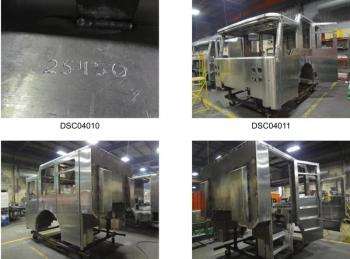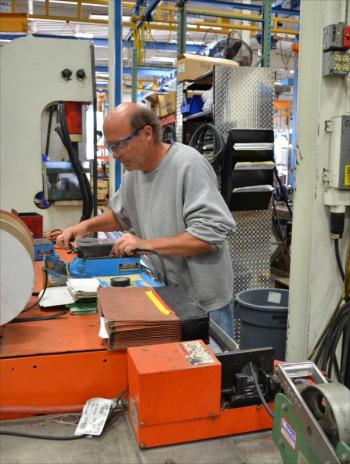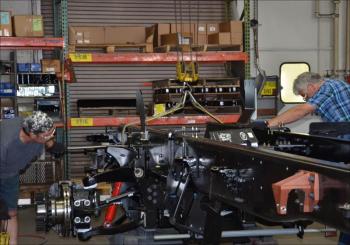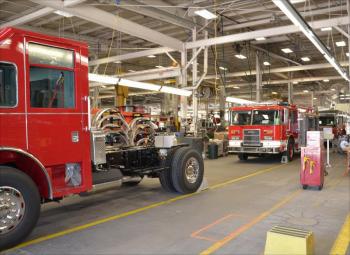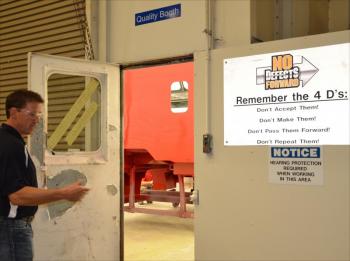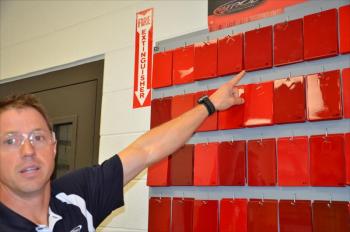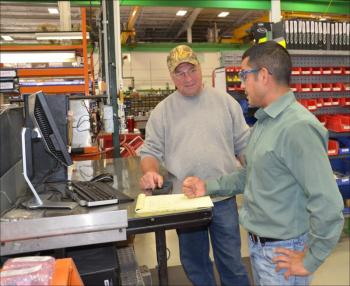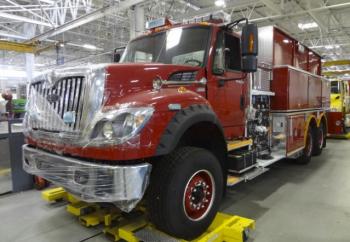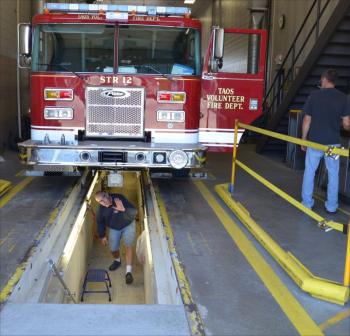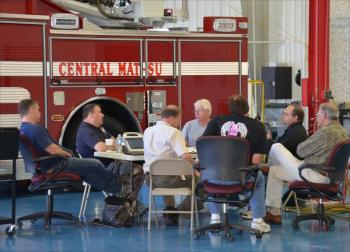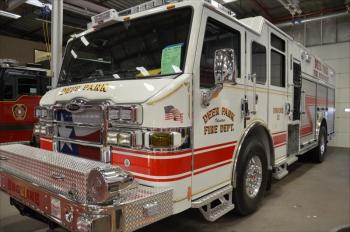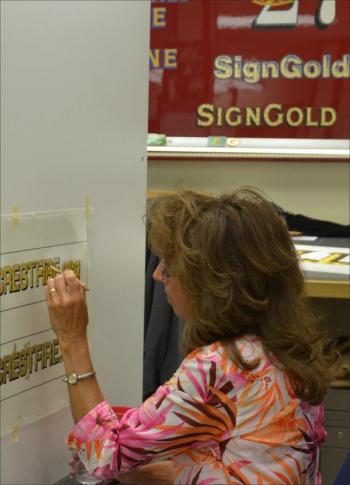The Maine-Wisconsin connection: Who builds these fire trucks taxpayers buy?
APPLETON, Wis. — Slinging open a heavy security door that separates 63 acres of a manufacturing plant from a small corporate waiting room, Brad White, a man with all the quiet intensity of a defensive hockey player, evaluates his visitor with a single glance.
“You're the reporter from Maine?” he says, holding out a hand and grinning, cracking a few jokes about which state might be colder in the winter, Maine or Wisconsin. Camden and Appleton (population 72,600), Wis., a small city just to the north of Oshkosh and near the shores of Lake Winnebago, happen to share the same latitude at 44 degrees, with just two-tenths of a degree of separation. It's not the only connection between these two northern communities, as the two are dealing in fundamental commerce.
We are at Pierce Manufacturing, the largest fire truck manufacturer in the country, and the company that is now building new fire trucks for Camden and Lincolnville.
Appleton is a purposeful place, with light manufacturing in a great Midwest sea of corn fields and dairy farms. Though 1,000 miles away, it is a lot like Maine, with the trees, lakes, clear air, and a similar sense of efficiency. Aside from the lack of a seabreeze, the real difference lies in the soil beneath our feet: in Maine, the dirt is a thin brown line between us and the granite; there, it is grey and loamy, rich soil that pulled so many settlers westward from New England.
Like the workers that fill the factory we are about to tour, White exudes Midwestern warmth, with a no-nonsense attitude, 'this is how we do things, this is why we get things done.' Now in project management, White has been with Pierce for 16 years, having started there in engineering and design. Many of the workers at the Pierce plant grew up on farms, learning how to tend to large animals and repair larger equipment, the tractors, combines and swathers. Their names reflect German or Scandinavian descent, and their churches are predominantly Lutheran and Catholic. Other workers represent the changing face of America; their parents are from Mexico, or they are from Vietnam, landing in Wisconsin after the Vietnam War.
And many of the employees have been at Pierce for 20 to 40 years, taking a lot of pride in what they build, and carry, said White, "so much product knowledge."
It is the kind of manufacturing strength narrated in corporate commercials that air during the Superbowl; yet, here, in a factory bustling on a Friday August morning, it is real. Employees stop to talk about the trucks under construction, the materials they use, how they are custom-wiring cabs for individual fire departments, or how they gild gold crests on a fire truck. Camden's truck, especially, is a topic of discussion, because it one of the company's most innovative designs — so new that its prototype sits in the lobby, where visitors from all over the world can't help but open its doors and sit in the driver's seat.
Pierce is a subsidiary of Oshkosh Inc., a $7.6 billion business that builds defense and emergency vehicles, refuse hauling and specialty trucks in plants around the world. Pierce produces fire and emergency vehicles, and represents 10 percent of the Oshkosh business. Its Appleton plant, the largest of three, is filled with trucks bound for China, Middle East oil fields, airport runways, army bases, cities like Memphis, San Diego and Toronto, and small American towns, such as Camden and Lincolnville.
This September, work is under way at the Appleton, Wis., plant on a new $542,000 fire truck that Camden voters approved acquiring last November. In Florida, at Pierce's sister manufacturing site in Bradenton, a new $332,000 tanker is almost completed for Lincolnville. Forty-two percent of that cost is funded by donations from the fundraising portfolio of Lincolnville Fire Department, the rest shouldered by Lincolnville taxpayers, who approved the purchase at town meeting last June.
Camden's truck, a Dash CF, has a delivery date of late December; the Lincolnville tanker will be in Woburn, Mass., in mid-October. Members of the Lincolnville Fire Department, including Chief Jason Peasley, will climb into a limousine (Peter Rollins, deputy fire chief owns a limousine company) and drive to Massachusetts to make the final inspection of the truck. If it passes muster, the tanker will head home to Maine. Likewise, Camden Fire Chief Chris Farley will travel to Wisconsin in late November to inspect progress on that town's truck. It is all part of a careful process designed to ensure the parties are satisfied with the product. Some inspections can continue for two days, drawing fire department teams to gather around long tables on the factory floor near their new vehicle, where they pore over design blueprints and checklists, and crawl inside, on top of and even under the truck.
Both the Camden and Lincolnville trucks represent tremendous investments for their communities, not just in dollars, but in pride taken for the efficient protection of the public's assets and safety. There is a reason that towns throughout the country bring out their firetrucks and ambulances for parades: they represent the careful tending a town takes of itself. Pierce understands that emotional draw, and has built a business around satisfying not just the delivery of an emergency response vehicle, but a symbol of community strength.
And as Camden and Lincolnville taxpayers spend money on these trucks, they also feed local economies in the Midwest and Florida, where factory employees assemble the vehicles; likewise, the bottom line of Oshkosh increases, and the shareholders of the publicly-held company see investment returns.
For Camden's Fire Department, the new Dash CF will replace — over the span of a few years — engines 1 (A 1990 truck that was built by E-One) and 6 (read a column written in October 2011 by Camden's fire chief about this new multi-purpose truck), as their value and usefulness diminish. In Lincolnville, the new 3,000-gallon tanker will replace a smaller 1,000-gallon tanker built in 1981, tripling the amount of water that can be transported to a fire in a town with few hydrants and 56 miles of mostly rural roads.
These purchases do not come lightly to the departments, and they only result following hours of discussions over the course of several years by firefighters and committees, presentations before town leaders and the public, and final municipal votes. In Lincolnville, fire apparatus acquisitions are scheduled for every seven years, and carefully budgeted for in the town's capital improvement plan.
"Lincolnville is very wise with its money," said Peasley.
Most communities across the country go through similar processes, as they upgrade public safety equipment on a regular basis. Older trucks are retired or sold to smaller towns (Lincolnville will sell or donate its old tanker to an island or small community and Camden's truck is already being listed for sale), as requests for bids to build new ones are circulated to any of the 18-plus fire truck manufacturing plants in the United States.
A big business
Fire truck manufacturing in the U.S. had reported revenues of $4 billion last year, with Pierce being the industry's largest player, followed by Rosenbauer America, in Minnesota. Pierce builds custom and commercial firefighting vehicles and equipment, aircraft rescue and firefighting vehicles, snow removal vehicles, and other emergency vehicles primarily sold to fire departments and airports, as well as broadcast vehicles sold to TV stations here and abroad, according to its most recent April filings with the Securities Exchange Commission.
But a deep recession clipped the fire truck business as municipalities, strapped for property taxes and grants, cut back on annual budgeting for capital improvements. Sales decreased 15 percent in 2009, and another 8 percent this year. At the local level, the pinch was also felt: Federal Assistance to Firefighters Grants appropriation funding, through Homeland Security, has fallen at an average rate of 9.2 percent since 2007, according to industry analysts at IBISWorld.
Those grants help fire departments invest in new equipment, gear and training. In 2004, the assistance totaled $746 million; in 2010, it dropped to $390 million. This year, federal funding stood at $285 million. Meanwhile, the grant requests from fire departments have reached as much as $2.6 billion.
Camden was one of those fire departments that tried to obtain a grant to help pay for its new truck, but was turned down this year.
While industry forecasters say an improving economy, increasing tax revenue and the fact that trucks are aging out will all push sales up, a company such as Pierce gets even more aggressive in trying to secure contracts.
"The large cities turn their trucks around every eight years," said White. "They are running their trucks all the time. At a certain point, their trucks are no longer safe, and the fleet of fire trucks is getting older. The average age of the U.S. fleet was 20 years, now it is 25 years."
One of its four business strategies is “market recovery and growth,” to “get back” to its average prior peak rates in markets that have been down in the Great Recession. The recession hit the Appleton plant hard, and in 2011, the company laid off 107 employees, according to news reports. Last month, Pierce shut down completely its ambulance manufacturing facility in Bradenton, Fla.
While the ambulance and the defense markets contract, however, the fire truck business is beginning to expand once again. This September, the company delivered five rescue and firefighting vehicles to Singapore's Changi airport. In April, the company received an order for 30 custom fire trucks from the Brasilia Fire Department in Brazil.
In 2010, Pierce made its first thrust into the Chinese market.
“We get big orders from China to buy trucks, in large groups of units,” said White. “They love American products and understand quality.”
Oshkosh reported in July that fire and emergency net sales increased 13.9 percent to $246 million in the third quarter of 2012, compared to the same period in 2011. The increase reflected more shipments abroad, and the delivery of rapid intervention vehicles to the U.S. Air Force.
At the Appleton plant, fire trucks line the tarmac outside, bound for towns, cities, airports and oil fields around the world, shiny red or yellow, or even powder blue (that's Walkersville, Md.) with gold gilded municipal crests that identify their destinations: San Diego, Toronto, Fort Benning in Georgia, Alaska, Maine. Motorists zipping past on U.S. Route 41, the national highway that carries travelers from Lake Superior down the center of the country to Miami, can see the legions of fire trucks off to the side of the road.
In Camden, a committee consisting of seven firefighters, a Budget Committee member and two Select Board members convened in January 2010 to begin planning for a new truck. After a year of design research, discussions about the role of a new truck in the broader mutual aid pact with area towns, and Camden's own public safety needs, the decision was made to go with Pierce. In fact, Pierce was the only company to respond to the town's request for proposals, which was circulated to 16 manufacturers.
“We wanted a truck that is easy to maintain and repair, and easy for firefighters to use,” said Camden Fire Chief Chris Farley. “We also wanted greater visibility around the front and sides [pulling out of the station is a hazard with pedestrians on Washington Street in downtown Camden].”
Camden already has a Pierce-built truck, Engine 6, which is a 1981 engine that is still in service and considered one of the better quality trucks in the fleet. It was recently out for pump testing and the department characterized it on a Facebook post as, "the o" Camden's Engine 5 and its ladder trucks are also Pierce-built.
“This was a contributing factor in why we wanted to go with Pierce again,” said Farley.
That same respect for Pierce products holds in Lincolnville, where Peasley said, “most of our trucks are Pierce, and we are pleased with their quality.”
That town had received four bids for its new pumper.
Inside the plant
Pierce Manufacturing, which employs approximately 2,200 in three plants (1,700 in the Appleton factory), overhauled its production floor design to accommodate the constant flow of trucks in production, which at any one time, can number 300 vehicles in some stage of assembly. The assembly line follows a feng shui flow, looping through 800,000 square feet of space and at various points signs encourage excellence: "No Defects Forward! Remember the 4 Ds. Don't accept them, don't make them, don't pass them forward, don't repeat them."
National Geographic made a film about Pierce in 2008, part of its "Ultimate Factories" series, and described the facility as one where "highly skilled workers mix muscle and high-tech tools to create made-to-order rigs in approximately 45 days." Depending on the part of apparatus under construction — the chassis, cab, wiring, engine, doors, windows, brakes and interiors — teams of workers assemble-in pockets, their cabinets of tools and parts beside them. Many of the components are made in America. The engines and transmissions are built by Cummins and Allison; the harnesses that hold firefighters in their seats, and the seats themselves, are outsourced to other Midwest manufacturers.
The engineering process begins in the design department, as fire chiefs and engineers go back and forth on specific truck characteristics. Chassis frame rails are outsourced to a local foundry, where the vehicle's core is shaped from steel produced in the U.S. and then delivered to the Pierce facility. The galvanneal (a steel product with a zinc-iron alloy coating on the steel surface), stainless steel or aluminum for truck bodies is ordered from other U.S. manufacturers and shaped into cabs and compartments. But before being assembled, the components enter the first of three metal prep rooms — self-contained paint labs within the factory buildings that are equipped with air drafts that draw the paint fumes down below the floor into water-filled vats. The resultant slurry is then vacuumed and sent to hazardous waste landfills.
These labs are important not just to the quality of a paint job, but to the finished product of a shiny new truck.
"Firefighters take a lot of pride in their apparatus, and having a quality paint job," said White.
The paint chip room is an indication of that preference; the office is lined with paint samples, each with a number -- red, yellow, lime green, stardust blue.
"No. 50 is the paint color San Diego uses," said White. "They are a good customer of ours. There are some cool blue ones we've done, like powder blue of Walkersville, Md. We did one that was fluorescent orange."
Camden's trucks are Pierce No. 90 (candy apple red), the company's most commonly used shade of red. So is Lincolnville's.
Outside, trucks wait to get their alignment checked. Tarmac tests include loading the vehicle to the maximum weight, rolling the wheels over 9-inch curbs, making 90-degree turns at 20 miles per hours, and driving 35 miles per hour over a washboard road and 55 miles per hour over a smooth road.
Way off to the side, out of hearing range, sirens and lights are tested over and over again.
Then, the trucks are handed over to an independent testing company, Underwriters Laboratory, before the customer arrives to see the finished product.
Riding the next wave of safety
Camden's new Dash CF, is at the manufacturing front end of new model line and represents design upgrades that Pierce characterizes as its "next generation of fire apparatus." The company built a series of prototypes in its design and research department and somme of them were subsequently destroyed in crash tests, an outsourced safety business.
"They get blasted," said White.
A number of Dash CFs have been already built for customers and shipped to parts of the country as far apart as Texas and New Jersey.
Camden got acquainted with the Dash design in 2011, when Farley attended a New England Fire Chiefs Association tradeshow in Springfield, Massachusetts. Following that show, a salesman with Minuteman Fire & Rescue Apparatus, the Walpole-Mass.,-based Pierce dealer for Maine, as well as New Hampshire, Rhode Island and Vermont, drove the Dash to Camden, where firefighters got the chance to review its features.
Besides providing storage options for equipment — cold water rescue gear, brooms and shovels and chain saws — lower step heights, a shorter wheelbase and independent suspension, the Dash CF creates more space for firefighters to prepare for emergencies while on the road. The engine is moved further back from the front cab, creating driver and office space, and the design, according to White, "incorporates a lot of little things, such as accommodating how firefighters get in and out of firetrucks [there is a safe way, and that includes not holding onto the steering wheel while jumping down onto the street]." The windshield, which drops another 10-inches in depth for better visibility, curves around the front of the engine, and the truck is equipped with a trailer hitch that will be used as an anchor point for ropes and winches.
Its 450-horsepower Cummins-built engine is "green," according to Pierce, and after a major reconfiguration, now meets the Environmental Protection Agency's fuel economy guidelines. The truck carries a 65-gallon fuel tank. The EPA standards added cost to the vehicle, said White, but the engine and exhaust system now meets 2010 emission levels, reducing nitrogen oxide emissions and diesel particles.
"There are two ways to go green," said White. "Reduce fuel consumption and reduce emissions."
The truck's electrical system incorporates lighting from the deck, rear work lights, and scene lighting that include four 900-watt flood lights that sit atop a six-foot tower.
And to fix it all, should it ever break, mechanics can lift the entire cab up off the engine compartment, which sits beneath where the firefighters ride. The cab tilts forward, and that is its "ease of service" that Pierce advertises.
"Be ready," said Pierce. "Situation ready."
Editorial Director Lynda Clancy can be reached by email at lyndaclancy@penbaypilot.com or by calling 207-706-6657.



